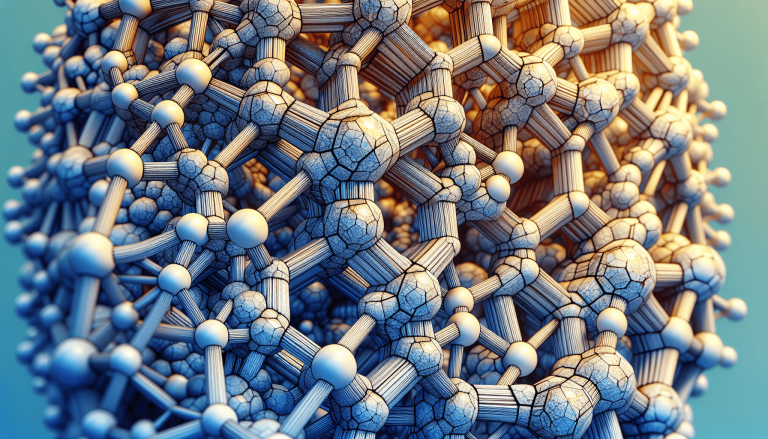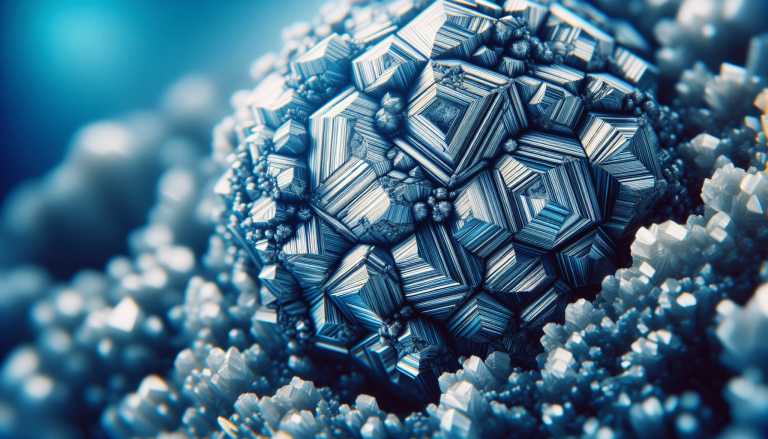The Role Of Crystal Structure In Determining Mineral Chemical Properties
Have you ever wondered why certain minerals have unique chemical properties? Well, it all comes down to the fascinating world of crystal structure. The arrangement of atoms in a mineral’s crystal lattice directly influences its chemical behavior and characteristics. From the strength of its bonds to its ability to conduct heat and electricity, crystal structure plays a crucial role in determining the properties of minerals. In this article, we will explore the intricate relationship between crystal structure and mineral chemical properties, highlighting its significance in the field of geology and material science.

Definition of Crystal Structure
The crystal structure refers to the arrangement and organization of atoms and molecules in crystalline solids. Crystalline solids are substances that have a regular repeating pattern of atoms or molecules, forming a crystal lattice structure. This structure is responsible for defining the physical and chemical properties of minerals. By studying the crystal structure of minerals, scientists can gain insights into various aspects of their composition, behavior, and reactivity.
Atoms and Molecules in Crystalline Solids
In crystalline solids, atoms or molecules are arranged in a highly ordered and repetitive manner. They are closely packed together in a three-dimensional arrangement, forming a crystal lattice. The crystal lattice structure is the result of the attractive forces between the atoms or molecules in the solid. These forces can be of different types, such as ionic bonds, covalent bonds, metallic bonds, van der Waals forces, and hydrogen bonds, depending on the nature of the atoms or molecules involved.
Lattice Structure
The lattice structure is a regular pattern of points or nodes within a crystal that represents the arrangement of atoms or molecules. It serves as a framework for the crystal structure. The lattice structure can be visualized as a three-dimensional grid, with each node representing a specific point in space occupied by an atom or molecule. The lattice structure is defined by the crystal system and class, which determine the symmetry and geometry of the crystal.
Unit Cells
A unit cell is the smallest repeating unit of the crystal lattice. It is a parallelepiped with edges defined by lattice parameters, angles between the edges, and lattice points at its corners. The unit cell represents the basic building block of the crystal structure and is replicated in all directions to form a complete crystal lattice. The shape and dimensions of the unit cell are determined by the crystal system and class of the mineral.
Crystal Systems and Classes
Crystals can be classified into different crystal systems based on their symmetry and lattice parameters. The seven crystal systems are cubic, tetragonal, orthorhombic, rhombohedral, monoclinic, triclinic, and hexagonal. Each crystal system exhibits a distinct set of symmetry operations and lattice parameters that define its unique crystal structure. Within each crystal system, minerals can further be classified into different crystal classes based on additional symmetry elements.
Crystallography and Mineralogy
Crystallography is the scientific study of crystals and their properties. It involves the analysis, characterization, and understanding of crystal structures using various techniques and methods. Mineralogy, on the other hand, focuses specifically on the study of minerals, including their composition, physical properties, and occurrence. Crystallography and mineralogy are closely interconnected, as the crystal structure plays a crucial role in determining the chemical properties of minerals.
Interrelation between Crystallography and Mineral Chemical Properties
The crystallographic properties of a mineral, such as its crystal shape and symmetry, are directly related to its chemical composition. The arrangement of atoms or molecules in the crystal lattice determines how they interact and bond with each other, which in turn affects the physical and chemical properties of the mineral. For example, the presence of certain elements or compounds in a mineral can result in specific crystal structures, giving rise to unique properties such as color, hardness, and luster.
Study of Crystals
The study of crystals involves various techniques and methods to determine their crystal structure and properties. X-ray diffraction is one of the most widely used techniques in crystallography. It involves passing X-rays through a crystal and measuring the angles and intensities of the diffracted beams. By analyzing the diffraction pattern, scientists can determine the arrangement of atoms or molecules in the crystal lattice.
X-ray Diffraction
X-ray diffraction is a powerful tool for determining the crystal structure of minerals. When X-rays interact with a crystal lattice, they scatter in a pattern that is characteristic of the crystal structure. By measuring the angles and intensities of the diffracted X-rays, scientists can obtain information about the unit cell dimensions, atomic positions, and bonding arrangements within the crystal lattice. X-ray diffraction can also be used to identify minerals based on their unique diffraction patterns.
Mineral Identification
The crystal structure plays a significant role in mineral identification. By analyzing the physical and chemical properties of a mineral, including its crystal habit, cleavage, hardness, and optical properties, geologists and mineralogists can make educated guesses about its crystal structure. This information, along with X-ray diffraction data, can be used to confirm the identity of a mineral and classify it within a specific crystal system and class.
Atomic Arrangement in Minerals
The atomic arrangement in minerals refers to the specific positions and bonding arrangements of atoms within the crystal lattice. Different types of bonding, such as ionic, covalent, metallic, van der Waals, and hydrogen bonding, can occur in minerals, depending on the nature of the elements or compounds involved. The arrangement of atoms and the strength of bonding within the crystal lattice determine the physical and chemical properties of the mineral.
Ionic Bonds
Ionic bonds occur when there is a transfer of electrons from one atom to another, resulting in the formation of positively and negatively charged ions. These ions are held together by electrostatic forces, creating an ionic lattice structure. Minerals that have ionic bonding often exhibit high melting points, hardness, and electrical conductivity.
Covalent Bonds
Covalent bonds occur when atoms share electrons to achieve a stable electron configuration. This type of bonding is common in minerals with non-metallic elements, such as carbon and silicon. Covalent bonding leads to a strong, directional bond, resulting in high melting points and hardness in covalent-bonded minerals.
Metallic Bonds
Metallic bonds occur between metal atoms, where the valence electrons are delocalized and free to move within the crystal lattice. This creates a “sea of electrons” that holds the metal atoms together. Metallic bonding gives rise to the characteristic properties of metals, such as malleability, ductility, and high thermal and electrical conductivity.
Van der Waals Forces
Van der Waals forces are weak attractive forces that exist between neutral atoms or molecules. They arise from temporary fluctuations in electron density and can be influenced by factors such as molecular shape and size. Van der Waals forces are responsible for the cohesion of some minerals, such as graphite and mica, and contribute to their unique physical properties.
Hydrogen Bonds
Hydrogen bonds are a specific type of weak chemical bond that occurs between a hydrogen atom bonded to an electronegative atom, such as oxygen or nitrogen, and a nearby electronegative atom. Hydrogen bonding is responsible for many of the unique properties of water and plays a critical role in the structure and stability of biological molecules, such as DNA and proteins.
Mineral Chemical Composition
The chemical composition of a mineral refers to the types and amounts of elements and compounds present in its crystal structure. Minerals can be composed of a single element, such as native gold or sulfur, or a combination of elements to form various compounds. The major elements are those that occur in the highest abundances, while minor elements are present in smaller quantities. Trace elements are present in even smaller amounts but can have a significant impact on the properties and behavior of minerals.
Elements and Compounds in Minerals
Minerals can contain a wide range of elements, including metals, non-metals, metalloids, and even noble gases. These elements can combine to form various compounds, such as oxides, sulfides, carbonates, and silicates. The specific combination and arrangement of elements and compounds within the crystal structure determine the mineral’s properties and behavior.
Major and Minor Elements
The major elements in a mineral are those that make up the bulk of its composition. These elements are typically present in high abundances and play a significant role in determining the overall properties of the mineral. Minor elements, on the other hand, occur in smaller amounts but can still influence the mineral’s properties and behavior. For example, the presence of trace amounts of impurities or minor elements can give rise to variations in color, luster, or crystal structure.
Trace Elements
Trace elements refer to elements that occur in very small amounts in a mineral but can have a significant impact on its properties. For example, the presence of trace amounts of certain transition metals can give gems their characteristic colors. Trace elements can also affect the stability, durability, and reactivity of minerals, making them important considerations in various fields, from geology to materials science.
Impurities
Impurities in minerals refer to foreign substances that are present within the crystal lattice but are not essential components of the mineral. These impurities can arise from various sources, such as substitutions of chemically similar elements or incorporation of elements from the surrounding environment during the mineral’s formation. Impurities can modify the properties and appearance of minerals, leading to variations in color, clarity, and other physical properties.
Isomorphous Substitution
Isomorphous substitution occurs when two or more elements of similar size and charge can freely substitute for one another within the crystal lattice. This substitution can result in the formation of solid solutions, where the composition of the mineral varies smoothly between two or more end members. Isomorphous substitution can affect the physical and chemical properties of minerals, such as their hardness, melting point, and reactivity.
Solid Solutions
Solid solutions are homogeneous mixtures of two or more end members within the crystal lattice. They can occur when there is isomorphous substitution or partial replacement of elements in a mineral. Solid solutions can result in variations in properties, such as color, hardness, and density, depending on the composition of the mineral.
Physical Properties and Crystal Structure
The crystal structure of a mineral directly influences its physical properties. Some of the key physical properties that can be determined or inferred from the crystal structure include crystal habit, cleavage, fracture, hardness, density, color, luster, streak, transparency, and various optical properties.
Crystal Habit
Crystal habit refers to the characteristic shape and overall form of a crystal. It is influenced by the arrangement of atoms or molecules in the crystal lattice and can vary greatly among different minerals. Crystal habits can range from well-defined geometric forms, such as cubes or prisms, to more irregular shapes or aggregates. The crystal habit provides clues about the underlying crystal structure and can help in mineral identification.
Cleavage
Cleavage is a property of minerals that describes how they break along flat surfaces. It is a result of the crystal’s internal structure and the preferred planes of atomic bonding. Cleavage can range from perfect, where the mineral breaks cleanly and easily along specific planes, to poor or absent. The number and orientation of cleavage planes can vary among minerals and are used as diagnostic features in mineral identification.
Fracture
Fracture is the property of minerals that describes the way they break when no cleavage planes are present. Unlike cleavage, which results in smooth, flat surfaces, fractures can exhibit irregular, rough, or conchoidal patterns. Fracture can be described as conchoidal (shell-like), fibrous, splintery, or uneven, depending on the nature of the mineral.
Hardness
Hardness is a measure of a mineral’s resistance to scratching or indentation. It is determined by the strength of bonding between atoms or molecules in the crystal lattice. Minerals are ranked on the Mohs scale of hardness, which assigns a value from 1 to 10 based on a mineral’s ability to scratch another mineral. The hardness of a mineral is related to its crystal structure and the type and strength of bonding present.
Density
Density is a measure of the mass per unit volume of a mineral. It is influenced by the atomic arrangement and packing density within the crystal lattice. Different crystal structures and bonding types can result in different densities for minerals. Density can provide insights into the composition and structure of a mineral, as well as its potential geological origins.
Color
Color is one of the most noticeable properties of minerals and is often used in their identification. The color of a mineral is determined by the way it interacts with light, including the absorption, transmission, and reflection of specific wavelengths. The presence of certain elements or impurities within the crystal lattice can give rise to characteristic colors. However, color alone is not a reliable indicator of a mineral’s identity, as many minerals can exhibit variations in color.
Luster
Luster refers to the way light is reflected from the surface of a mineral. It is influenced by the interaction between light and the crystal lattice structure. Common types of luster include metallic, submetallic, non-metallic (vitreous, resinous, pearly, silky, greasy), and adamantine (highly reflective, like a diamond). Luster can provide clues about a mineral’s composition and crystal structure.
Streak
Streak is the color of the powdered form of a mineral. It is determined by rubbing the mineral against an unglazed porcelain plate or a streak plate. The streak color can sometimes differ from the color of the mineral itself. This is because the streak color is typically caused by the presence of trace elements or impurities in the mineral. The streak test can be a useful diagnostic tool in mineral identification.
Transparency
Transparency refers to the degree to which light can pass through a mineral. Minerals can be transparent, translucent (allowing partial light transmission), or opaque (no light transmission). The transparency of a mineral is related to its crystal structure, the presence of impurities, and the way atoms or molecules are arranged within the crystal lattice.
Optical Properties
The crystal structure of a mineral can have a significant impact on its optical properties. Minerals can exhibit various optical phenomena, including double refraction, birefringence, polarized light effects, and pleochroism. These properties arise from the anisotropy of the mineral structure and the different refractive indices in different crystallographic directions. Optical properties can provide insights into the crystal structure and composition of minerals.
Chemical Properties and Crystal Structure
The crystal structure of a mineral also influences its chemical properties and reactivity. The arrangement of atoms or molecules within the crystal lattice determines how they interact with other substances and the environment. The chemical properties of a mineral can include its reactivity, acid-base properties, oxidation-reduction reactions, solubility, and responses to changes in temperature and pressure.
Reactivity
The reactivity of a mineral refers to its ability to undergo chemical reactions with other substances. This can include reactions with acids, bases, oxidizing agents, reducing agents, and other chemicals. The arrangement and bonding of atoms within the crystal lattice can determine the susceptibility of a mineral to chemical reactions and its overall reactivity.

Acid-Base Properties
The acid-base properties of minerals refer to their ability to react with acids or bases. Some minerals may dissolve or react with acid solutions, while others may exhibit basic properties and react with bases. The acid-base properties of a mineral are influenced by its composition, crystal structure, and the nature of the elements or compounds it contains.
Oxidation-Reduction Reactions
Oxidation-reduction reactions involve the transfer of electrons between reactants. Some minerals can undergo oxidative or reductive processes when exposed to specific environmental conditions or react with other substances. The crystal structure and composition of minerals can influence their susceptibility to oxidation or reduction reactions, as well as the extent and nature of these reactions.
Solubility
Solubility refers to the ability of a mineral to dissolve in a solvent, such as water or acid. The crystal structure and chemical composition of a mineral can determine its solubility characteristics. Some minerals are highly soluble, while others are insoluble. Solubility can be influenced by factors such as the nature of bonding and the presence of specific elements or ions within the crystal lattice.
Temperature and Pressure Effects
Changes in temperature and pressure can have significant effects on mineral properties and behavior. Alterations in these conditions can induce phase transitions, where a mineral undergoes a transformation from one crystal structure to another. The response of a mineral to changes in temperature and pressure depends on its crystal structure, bonding type, and the stability of different phases under specific conditions.
Phase Transitions
Phase transitions occur when a mineral undergoes a change in its crystal structure due to changes in temperature, pressure, or other external factors. These transitions can result in variations in physical and chemical properties, such as changes in density, hardness, color, or reactivity. Phase transitions play a significant role in the behavior of minerals under different geological conditions.
Polymorphism and Crystal Structure
Polymorphism refers to the occurrence of different crystal structures for the same chemical compound. Polymorphs are minerals that have the same chemical composition but different crystal structures. This phenomenon can arise due to variations in temperature, pressure, cooling rate, or composition during the mineral’s formation. Polymorphism can significantly influence the physical and chemical properties of minerals, leading to variations in their behavior and reactivity.
Polymorphs
Polymorphs are minerals that exhibit different crystal structures while having the same chemical composition. These minerals can have similar or distinct physical and chemical properties, depending on their crystal structures. Polymorphism is a common phenomenon in minerals and can provide valuable insights into the conditions under which a mineral formed and the factors that influenced its crystal structure.
Allotropic Forms
Allotropy refers to the existence of different forms or allotropes of an element in different crystal structures. Some elements can exhibit multiple allotropes, each with a unique crystal structure and properties. Allotropic forms can have different physical and chemical properties, such as variations in density, hardness, melting point, or reactivity. The crystal structure of allotropic forms plays a crucial role in determining their properties and behavior.
Stable and Metastable Phases
In addition to polymorphs, minerals can exist in stable or metastable phases. Stable phases are thermodynamically favored under specific conditions and represent the most energetically favorable crystal structure for a given composition. Metastable phases, on the other hand, may form under certain conditions but are not in thermodynamic equilibrium. Metastable phases can undergo phase transitions to more stable phases over time, resulting in changes in the mineral’s crystal structure and properties.
Polymorphism and Mineral Properties
Polymorphism can have profound implications for mineral properties and behavior. Different polymorphs of the same mineral can exhibit variations in hardness, melting point, reactivity, and other physical and chemical properties. These differences arise from the distinct atomic arrangements within the crystal lattice. Polymorphism can also affect the stability, durability, and geological occurrence of minerals, making it a crucial consideration in mineralogical research and applications.
Crystal Defects and Structural Imperfections
Crystal defects and structural imperfections are deviations from the ideal, periodic arrangement of atoms or molecules in a crystal lattice. These defects can occur during the formation and growth of a mineral and can have significant effects on its physical and chemical properties. Crystal defects can include point defects, such as vacancies or interstitial atoms, as well as line and planar defects, such as dislocations or grain boundaries.
Point Defects
Point defects are localized deviations from the ideal crystal structure and involve the presence of extra or missing atoms in the crystal lattice. These defects can result from the incorporation of impurities, temperature-induced atomic vibrations, or other factors. Point defects can affect various properties of minerals, including their electrical conductivity, optical properties, and elasticity.
Line and Planar Defects
Line and planar defects involve deviations along lines or planes within the crystal lattice. They can include dislocations, stacking faults, twin boundaries, or grain boundaries. Line and planar defects can significantly affect the mechanical properties of minerals, such as their strength, ductility, and deformation behavior. They can also influence the reactivity and transport properties of minerals, as well as their response to external stimuli, such as pressure or temperature.
Influence on Mineral Properties
Crystal defects and structural imperfections can have profound effects on the properties and behavior of minerals. They can influence physical properties, such as electrical conductivity, thermal conductivity, mechanical strength, and elasticity. They can also affect chemical properties and reactivity, such as catalytic activity, ion diffusion, and surface reactions. Crystal defects can be intentional, induced for specific applications, or natural, resulting from the geological formation process.
Crystallographic Controls on Mineral Properties
The crystal structure can exert significant controls on the properties of minerals. The anisotropy of crystal structures, arising from the variations in bonding and symmetry in different crystallographic directions, can result in anisotropic properties. These properties can vary depending on the direction of measurement or observation. Crystallographic controls can impact the behavior of minerals under different geological conditions, such as heat and pressure, and influence processes like crystal growth and mineral formation.
Anisotropy
Anisotropy refers to the property of exhibiting different values or behaviors in different crystallographic directions. Minerals with anisotropic properties can exhibit variations in physical and optical properties, such as refractive index, thermal conductivity, and electrical conductivity, depending on the direction of measurement or observation. Anisotropy is a result of the crystal structure and bonding arrangements in different crystallographic directions.
Petrofabric Analysis
Petrofabric analysis involves the study of the fabric or orientation patterns of minerals within a rock or geological sample. The fabric is influenced by the crystallographic controls on mineral properties, such as preferred crystal orientation, alignment, or cleavage patterns. Petrofabric analysis can provide insights into the deformation history, flow patterns, or growth mechanisms of rocks and minerals, contributing to the understanding of geological processes and tectonic events.
Heat and Pressure Effects
Changes in temperature and pressure can have significant effects on mineral properties and behavior. Heat can induce phase transitions, alter crystal structures, or cause changes in crystallographic properties, such as thermal expansion or contraction. Pressure can also induce phase transitions, affect crystal structures, or lead to changes in mechanical properties, such as compressibility or elastic behavior. The crystal structure plays a crucial role in determining the response of minerals to heat and pressure.
Crystal Growth and Mineral Formation
The crystal structure of minerals can provide insights into their formation processes. Crystal growth occurs when atoms or molecules come together in a specific arrangement to form a crystal lattice. The crystal structure determines the symmetry, shape, and overall habit of the resulting crystal. The conditions under which a mineral forms, such as temperature, pressure, and available elements, can influence its crystal structure and affect its properties.
Applications and Significance
The study of crystal structure and its influence on mineral chemical properties has significant applications in various fields.
Geological Exploration
Understanding crystal structures and their relationship to mineral properties is essential for geological exploration. By studying the crystal structures of minerals, geologists can interpret the conditions under which rocks and ores formed, identify potential mineral resources, and predict their behavior in different geological settings. Crystallography and mineralogy are critical tools for mineral exploration and resource assessment.
Mineral Processing
Crystal structure analysis plays a crucial role in mineral processing operations. By understanding the crystal structure and chemical composition of minerals, engineers and metallurgists can optimize mineral extraction techniques, design efficient mineral processing flowsheets, and tailor treatment processes to maximize ore recovery and quality. Crystallography and mineralogy contribute to the development of sustainable and environmentally friendly mineral processing practices.
Material Science
The study of crystal structure and its influence on mineral chemical properties is vital in materials science. By understanding the atomic arrangements and bonding within crystals, scientists can design and develop materials with specific properties and tailored functionalities. Crystallography and mineralogy provide insights into the structure-property relationships of materials, contributing to the advancement of technologies such as semiconductors, catalysts, superconductors, and photovoltaics.
Gemology
Crystal structure analysis is of great importance in the field of gemology. The unique crystal structures of gemstones determine their optical properties, durability, refractive index, and overall beauty. Gemologists study the crystal structures of minerals to identify and evaluate gemstones, predict their behavior during cutting and polishing, and understand their formation processes. Crystallography and mineralogy are essential in the appreciation, valuation, and characterization of gemstones.
In conclusion, the crystal structure is a fundamental aspect of minerals that determines their physical and chemical properties. By studying the crystal structures of minerals, scientists can gain insights into their composition, behavior, and reactivity. The crystal structure provides the framework for understanding and predicting mineral chemical properties, which have significant applications in geological exploration, mineral processing, material science, and gemology. Crystallography and mineralogy play crucial roles in advancing our understanding of the natural world and the materials that surround us.







